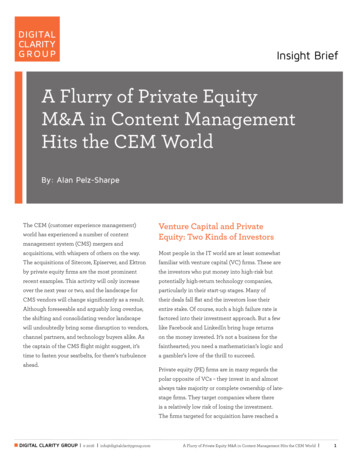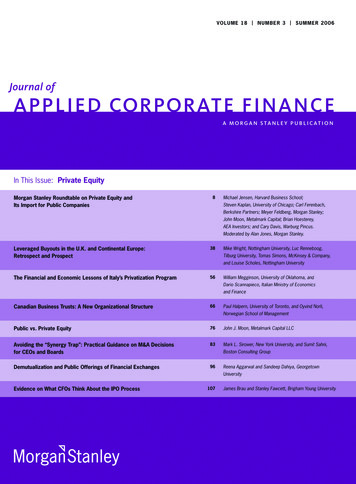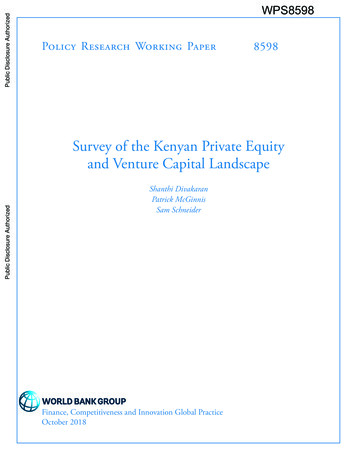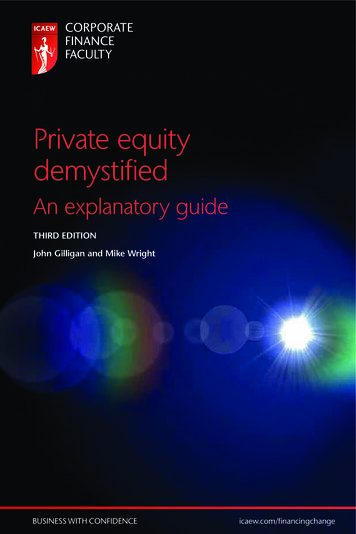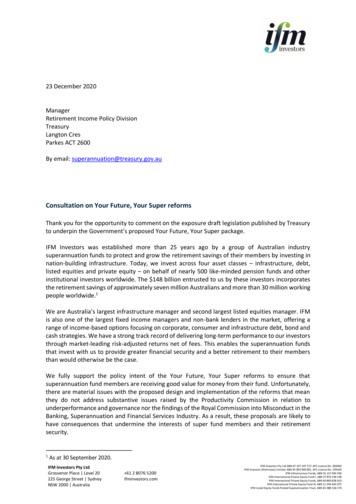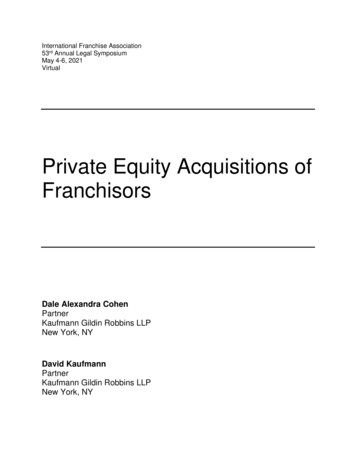
Transcription
International Franchise Association53rd Annual Legal SymposiumMay 4-6, 2021VirtualPrivate Equity Acquisitions ofFranchisorsDale Alexandra CohenPartnerKaufmann Gildin Robbins LLPNew York, NYDavid KaufmannPartnerKaufmann Gildin Robbins LLPNew York, NY
I.IntroductionPrivate equity acquisitions of franchisors and large franchisees is a phenomenonthat has transformed the franchising landscape over the past two decades. BerkshireHathaway owns Dairy Queen, which it acquired in 1998. Trian Partners L.P. owns acontrolling stake in Wendy’s. Roark Capital affiliates now own the Dunkin, Arby’s,Baskin-Robbins, Buffalo Wild Wings, Jimmy John’s, Seattle’s Best, Schlotzky’s, AuntieAnne’s Pretzels, Moe’s Southwest Grill, Sonic and ServiceMaster Brands (among manyothers). TZP Group a few years ago acquired The Dwyer Group. And in the largestacquisition of a franchisor ever, a fund of the Blackstone Group acquired HiltonWorldwide, Inc. for approximately 25 billion in 20071. While this trend has beengrowing for the last twenty years, it has grown exponentially during the last ten years –a trend driven by, among other factors, franchising’s proven track record of success withhigh, steady, returns; the embrace of the franchise business model by Wall Street, thepublic markets and lenders; the rise of securitizations; a nearly zero interest rateenvironment; and, enormous pools of capital allocated by large pension funds,sovereign wealth funds, wealthy families and college endowments to private equity.Although there is increasingly more and more private equity activity in large multi-unitoperators, this paper will focus on the private equity acquisition of entire franchisesystems.This paper provides an outline of the following key topics:1. What are the goals of private equity investment infranchise companies?2. How are acquisitions structured?3. How is the pricing of acquisitions determined and when isthe price paid?4. What are the most essential franchise-related issues tobe analyzed in due diligence?5. Do acquisitions raise any disclosure issues?II.Goals of Private Equity Investment in Franchise CompaniesA. Typical Goals of Franchise M&APrivate equity acquisitions of franchisors are based on an array of sound andcompelling determinants.1Full disclosure: author Ms. Cohen’s law firm served as franchise counsel in the Hilton transaction and inTrian’s acquisition of a controlling interest in Wendy’s.2
First and foremost is the appeal of franchising as a business model. Thefranchise model requires a relatively modest capital investment on the part of thefranchisor. While a franchisor must undoubtedly spend a significant amount of time,energy and capital developing its concept and franchise system, once the systemreaches a critical mass, it generally requires less capital to operate over time. At thesame time, a franchisee is generally required to pay its franchisor a set royalty (andother) fee, typically based on a percentage of its gross revenue, for a set period of time.Thus, a private equity buyer of a healthy franchise system is commonly able to operatethe franchise company for deceasing costs while simultaneously achieving steady,recurring, long term revenues and predictable cash flow – characteristics particularlydesirable to private equity investors.In addition, although some private equity investors are interested in turningaround mature franchise systems, the majority are interested in opportunities for growthand expansion. By way of example, a franchise system may have strong uniteconomics but a limited geographic footprint, and the franchisor may lack sufficientcapital or access to capital to support an experienced franchises sales and developmentteam. In this case, the ability of a private equity firm to buy the franchise system, hirethe necessary management personnel and invest in a franchise sales infrastructure mayallow the brand to focus on development and expansion into new territories. Multiplyingstrong unit economics with growing development enables the private equity firm toreturn increasing profit over time.Further, private equity investors generally look for the ability of the acquiredtarget to add significantly to the private equity firm’s return on investment, achieved byincreasing the target’s EBITDA (earnings before interest, taxes, depreciation andamortization) once the acquisition price has been fully recouped. Indeed, often, thetarget’s post-acquisition EBITDA will be enhanced through savings achieved followingconsolidation by the acquiror - - duplicative target senior management can be releasedand their compensation packages driven to the bottom line; duplicative facilities of thetarget (warehouses, distribution centers, regional offices, IT and the like) can likewisebe eliminated at great cost savings; the combined purchasing power of the acquiror andthe target can drive down the cost of critical products and services; and, whereapplicable, goods and services previously procured by the target’s franchisees fromthird parties may, following the acquisition, be procured from the private equityconcern’s other holdings.Likewise, many private equity investors have taken advantage of the benefitsassociated with a multi-brand franchise strategy, where a private equity fund owns anumbrella holding company, which owns several different franchise brands. By way ofexample, Lift Brands owns Snap Fitness, 9-Round, Yoga Fit, Steele Fitness, andFitness on Demand, and Regis Corporation owns Supercuts, Jean Louis David, VidalSassoon, Regis Salons, MasterCuts, Trade Secret, SmartStyle, Cost Cutters and HairClub for Men and Women. Similar to the point raised above, the back-officeinfrastructure (i.e., accounting, HR, legal and operations) needed to support one brandcan often times support multiple brands. By sharing the various brands’ overhead3
expenses, the holding company is able to drive down overhead costs, increase profitand create value.It is also possible that multiple brands share synergies such as their targetcustomers and target franchisee pool. A franchisor targeted for acquisition may offercomplementary products or services to those already offered by one or more brandsowned by the fund. Where this is the case, the holding company is able to save frontend costs related to advertising/marketing, real estate and referrals based, in part, oneconomies of scale in purchasing power and other matters, while also potentiallyincreasing revenues through the ability to service more than one customer need.Adding an additional franchise brand may also help the company grow and diversifythroughout different geographic areas, as well as balance cyclical market rotations. Inall, private equity investors see these sorts of strategic synergistic acquisitions as a toolto increase profits, drive value and ultimately achieve greater returns on theirinvestments.While franchise securitizations are not the subject of this paper, it is important tonote the role that this method of financing has played in the proliferation of franchiseacquisitions. In a whole business franchise securitization, the franchisor will securitizeits future revenues (i.e., its royalties, company-owned outlet revenues and othersources of income) in order to raise debt at a relatively low interest rate. Whereas afranchisor raising money through traditional financing methods would typically need tosatisfy an assortment of restrictive ongoing covenants in addition to a certain level ofcreditworthiness, in a securitization, such historical criteria are typically less important.Instead, the franchisor will isolate its future revenue stream from its operations andliabilities in order to become bankruptcy remote which, as a practical matter, generallyoffers more security to the bondholders. Because the financing is secured by thefranchisor’s future royalties and therefore theoretically involves less risk than a loan thatis not backed by any such revenue or collateral, the franchisor is typically able to save amaterial amount of money in interest payments compared to traditional sources. As aresult, the securitization financing allows the franchisor to pay a relatively low cost forgrowth. In addition, the securitization debt is portable, meaning that debt stays with thefranchisor even upon a stock sale of the company (as discussed in Section III below),thereby facilitating the exit options available to the franchisor and its private equityinvestor upon a sale.B. Impact of COVID-19While the above factors have always been drivers of M&A activity in franchisecompanies, the COVID-19 pandemic has served as an additional catalyst. Thepandemic has been an unprecedented event, causing severe economic disruption.However, time after time, history has demonstrated that periods of great economicdisruption present the best investment opportunities.Beginning in March of 2020, the revenues of many franchise systems seeminglydisappeared overnight. This was particularly the case with many hotel brands, dine-in4
restaurants, gyms and spas. With little to no cash flow, if a business did not havesufficient reserves or access to emergency funds, its ability to remain open andoperating was limited. For these businesses, private equity investment offered theopportunity to stay afloat and avoid bankruptcy. And for certain private equity firms, thisunique period of economic disruption provided an opportunity to take a play out ofHoward Buffet’s book and “be greedy when others are fearful,” particularly with respectto the franchise brands that were on healthy footing prior to the pandemic. Given theCOVID-related consolidation of many brands, keen investors acted on the belief that thebrands that survive will be able to dominate the market following the pandemic.In stark contrast to the business sectors that were crushed by the pandemic,businesses in many other sectors - - such as small footprint QSR restaurants with afocus on delivery and take out, home repair and renovation businesses, home healthcare businesses, and others - - thrived. For these businesses, the pandemic served asa catalyst for growing interest and higher revenues. For private equity investors whothink that the COVID-19 pandemic will forever reshape society, investing in thesepandemic winners represented an opportunity to invest in brands best suited todominate in the “new normal” future marketplace.III.How are Acquisitions Structured?There are various methods available to structure an M&A deal, each with its ownparticular benefits and detriments. While the acquisition of a franchise system involvesmany of the same business considerations as acquisitions in other sectors, it alsoinvolves many idiosyncrasies particular to the niche world of franchising and franchiselaw. Thus, while it is important that the buyer and seller consider each acquisitionmethod with their respective legal, M&A, tax and accounting advisors in order to isolatethe preferred structure, it is also important that advisors knowledgeable about thebusiness, legal and regulatory framework of franchising be consulted. Through thisholistic approach, analyzing all tax, liability, simplicity and franchise law and relationshipconsiderations in tandem, the parties will be able to isolate the structure that works bestfor them.With that in mind, the two most common methods of structuring an acquisition ofa franchise company are stock/equity acquisitions and asset acquisitions. Each ofthese structures are described below.A. Stock / Equity AcquisitionsA stock acquisition, where the buyer simply acquires all of the stock of the targetcompany and continues to operate it as a going concern, is generally considered to bethe most straight forward structure and is therefore by far the most common structureutilized. The benefits of this approach are several.First, because the target company continues to operate in its current form, thereare often less third-party consents and sign-offs needed in order to consummate the5
transaction. By way of example, while franchise, lease, vendor and other agreementssometimes provide that neither party may assign the agreement without the otherparty’s prior consent, in a stock sale, this restriction is not triggered (unless theagreement has a change in control restriction, discussed below). Because the targetcompany remains the applicable counterpart to the subject agreement, no such priorconsent is necessary; as such, the parties can avoid the significant time andcomplications that may be associated with obtaining same.Second, there are certain administrative simplicities. Unlike in an asset sale,where it is necessary for the buyer to hire and sometimes enter into employmentcontracts with the target company’s employees, in a stock acquisition, the targetcompany’s employees can simply remain employed (if the buyer wants, of course) bythe target company without any interruption in their operations.Third, there are several franchise registration and disclosure related benefits of astock acquisition. By way of example, while the target company’s Franchise DisclosureDocument may need to be amended to disclose the new ownership and control, thenew board of directors (if any) and the new management (if any), that is it. The buyerwill not need to capitalize a new entity, go through the significant time and expense ofpreparing new audited financial statements of such entity, and then conduct an analysisof whether there are any changes necessary in the target company’s registration versusexemption strategy (i.e., whether previously secured exemptions from state franchiseregistration requirements based on the franchisor’s net worth and experience continueto apply). Instead, the buyer may continue using the target company’s existing financialstatements (though, note that if the target company amends its Franchise DisclosureDocument to disclose the change in ownership or control, or any other post-acquisitionsystem changes, such that it will be required to file a post-effective amendment with thestates in the middle of a renewal cycle, “stub” period unaudited financial statements willneed to be produced and disclosed).Lastly, there can be tax benefits associated with a stock sale, such as theavoidance of real estate transfer taxes, sales taxes and capital gains taxes.Notwithstanding this fact, there are a multitude of factors which may affect the taximplications of a particular transaction. It is therefore recommended that both the buyerand seller work with tax accountants and lawyers to achieve the desired result.While often considered the simplest approach, a stock sale does still have is ownset of particular complications and risk (though they are often considered relativelymanageable). One of the most significant risks of a stock sale (for the buyer, at least) isthe assumption of all of the target company's assets and liabilities that are notspecifically excluded by the contract. A stock purchase agreement will typically includea schedule of all actual or alleged claims, litigation and liabilities, which are, of course,figured into the purchase price. However, it is possible that at the time of the sale, thetarget company is unaware of certain liabilities or that certain claims have not yet fullyripened. The buyer can usually mitigate this potential risk, however, by requiring thetarget company to: A. indemnify, defend and hold it harmless for any claims which are6
alleged after the closing of the stock purchase agreement but which are based oncompany operations prior to the closing; B. obtain and maintain insurance in sufficientlimits to cover claims which may arise under the indemnification provision; and/or C.agree to a “hold back provision”, essentially allowing the buyer to hold back payment ofa certain portion of the purchase price for a period of time in order to cover any suchclaims which may arise. We note, however, that in the current seller’s market - - whereprivate equity funds are increasingly in competition to chase deals for growing franchisecompanies - - these historic risk mitigation tactics have been invoked less frequently.B. Asset AcquisitionsIronically, if the simplicity of a stock sale is its greatest advantage, the intricacy ofan asset sale is its greatest advantage. As opposed to a stock sale, where, asdescribed above, the buyer essentially steps into the shoes of the target company,acquiring the assets and liabilities and operates it as a going concern, in an asset sale,the buyer can identify which particular assets and liabilities (or no liabilities at all) it willacquire and, most importantly, which it will not. If the asset purchase agreement doesnot expressly state that a particular trademark, website domain, employee, vendoragreement, claim, company-owned outlet or otherwise is included in the sale, thattrademark, website domain, employee, vendor agreement, claim, company-ownedoutlet or otherwise - - along with all the liabilities associated therewith - - remain with thetarget company. In addition to avoiding the acquisition of known liabilities, thisapproach also avoids the unintended acquisition of unknown or unripe liabilities. In thisway, an asset sale is a much more targeted and controlled acquisition than a stock sale.Along with this targeting, however, comes additional risks and complications.Because any assets not specifically stated in the asset purchase agreement are notacquired, it is crucial that deal counsel take great care to ensure that all assets intendedto be acquired, whether tangible and/or intangible, are expressly included in the assetpurchase agreement.There are also a number of additional franchise-related hoops that a buyer willhave to jump through in connection with an asset acquisition. Because the buyer is, bydefinition, a different business entity than the target company, it will need to: undergothe time and expense of preparing audited financial statements; likely complete a morein-depth revision of the brand’s Franchise Disclosure Document; and, file initialapplications for state franchise and business opportunity registration or exemption, asapplicable (which often take longer for the states to process than amendmentapplications, as would be the case in a stock purchase, as noted above). Completingthese tasks will typically result in a longer franchise sales black-out period, during whichtime the franchisor will have to refrain from engaging in franchise sales activities(including, without limitation, entering into any renewal agreements, transferagreements and the like).7
C. Additional Acquisition StructuresWhile stock and asset acquisitions are the most common structures utilized forfranchise acquisitions, we note that they are not the only structures possible. Additionalstructures include, by way of example but without limitation, tender offers (where aprivate equity fund will seek to acquire ownership of a public company by offering to buyout the shareholders at a certain per share price); minority investments (where theprivate equity firm will not acquire the entire brand but rather a non-controlling minorityinterest in the brand); and, mergers (where the private equity firm merge the targetcompany into one of its existing brands, or more likely form a new subsidiary companyto merge with the target company).IV.How is the Pricing of Acquisitions Determined and When is the PricePaid?Let us now address a critical issue in private equity acquisitions of franchisors –acquisition pricing. Before turning to the determinants at issue, we must emphasize thathistorically, the private equity acquiror would not pay the full purchase price up front.Instead, the private equity acquiror would initially acquire 70-80% of the franchisor’sequity and then either purchase the balance later and/or permit the original equity ownerto retain such balance and cash it in when the private equity concern exercises its exitoption (generally through a subsequent sale of the franchisor or, if the franchisor is largeenough, taking it public, in either event usually five to seven years following the initialacquisition).There exists a universe of pricing models which private equity concerns mayutilize in determining the ultimate purchase price they are willing to expend toaccomplish the subject acquisition. Each has its own raison d’etre and legitimacy.In certain instances, a percentage multiple of the target’s gross revenues isutilized. In other settings, multiples of LTM (last twelve month) earnings per share. Inthe guest lodging segment, a key barometer of economic activity utilized is RevPAR(revenue per available room). Other times, multiples of the target’s LTM cash flow isthe basis around which a price is established. Infrequently, “book value” is employed.Comparable transactions can often prove a useful barometer. And “triangulation” of anumber of these variables will frequently be used to ascertain purchase price.But historically, the most common pricing determinant utilized in acquisitions(whether involving franchise companies or not) is a multiple of the target’s LTMEBITDA. A target’s EBITDA is viewed by many as the most accurate barometer of thattarget’s true value, of what that target truly earned over the past twelve months.Just what multiple EBITDA an acquiror is willing to pay is always a key subject ofnegotiation - - and will be affected by the economic climate. For example, in the heydayof the economic boom of the late 2010’s, relatively rich deals priced at multiples of 6 (oreven higher) times EBITDA were not uncommon. By contrast, throughout the COVID-8
19 pandemic, EBITDA multiples of certain companies declined as risk taking andoptimism diminished, such that EBITDA multiples of 4 – 4½ have been prevalent,whereas the EBITDA of other companies (such as growth franchise brands) haveexponentially increased, sometimes even surpassing multiples in the teens. In veryrough terms, the period of years it will take for an acquiror to recoup its investment inthe target is equivalent to the EBITDA multiplier used. Thereafter, the target’s EBITDAflows to the acquiror’s bottom line. For example, roughly speaking, if a target’s EBITDAis 10MM; the EBITDA multiple is four; and, the post-acquisition target’s EBITDAremains constant over the coming four years, then simple mathematics reveals that itwill take the acquiror four years of operating the target before the acquiror’s purchaseprice is recouped and subsequent target EBITDA becomes pure profit to the acquiror.Once the negotiation regarding precisely which EBITDA multiplier will be used toprice the transaction has been completed, only half of the mission is accomplished. Theother half consists of ascertaining precisely what the target’s LTM EBITDA truly wasand how it needs to be adjusted.It may appear counterintuitive that this exercise needs to be engaged in. Afterall, especially with public company targets, EBITDA is easily derived from auditedfinancial statements. But it is not as simple as that. Much investigation must go intojust how the target computed its LTM EBITDA and what adjustments thereto need to bemade to establish a transaction LTM EBITDA.For example, the target may have capitalized certain repair and maintenanceexpenditures which more properly should have been classified as expenses (therebyreducing LTM EBITDA). Interest income from investments and operating cash balancesare typically excluded when computing transaction EBITDA - - while interest incomefrom operations will likely be included. The target’s top tier management maydeliberately be receiving compensation packages that are well above market(particularly where, in non-public company settings, management owns all or part of thetarget); in such circumstances, negotiation will frequently reduce this expense to theamount that the acquiror will be paying its management team to operate the target postclosing, thus increasing LTM EBITDA.Also, to be “backed out” from a target’s LTM EBITDA are one-time transactionswhich are non-recurring in nature and artificially inflate earnings. For example, if thetarget is a franchisor which in the last twelve months engaged in refranchising activityand thus sold company-owned units, the LTM EBITDA of the target should bediminished by the net sales price derived from that transaction. The same logic pertainswhen a multi-unit franchisee is the target and it, too, engaged in non-recurringtransactions which will be viewed by the acquiror as artificially inflating LTM EBITDA.Conversely, if the target itself expanded its operations (through acquisitions, theconstruction of new units or otherwise), then LTM EBITDA may be increased torecognize the conservatively estimated addition to the target’s EBITDA which is not yetrealized but will predictably flow from such activity. If the target has made significant9
charitable contributions, then justifiably it will want to have its LTM EBITDA increased bythe amount of such contributions made over the past twelve months. If the target is amulti-unit franchisee in a network owned by its private equity acquiror, then thefranchisee’s LTM EBITDA is frequently increased by the amount of royalties it paid to itsfranchisor over the past twelve months.Once transaction LTM EBITDA and the multiple to be applied thereto have beenestablished, further steps must be undertaken before the ultimate purchase price isreached. The simplest step to address is the issue of the target’s cash. Generallyspeaking, cash at closing is paid for dollar for dollar, but is increased or reduced to theextent that the net working capital of the target, at closing, is greater or less than zero.Further, it is often the case that the target’s senior management team possesses“golden parachutes” which may or will be triggered by the transaction - - muchdiscussion usually takes place regarding who will pay the cost of those “goldenparachutes” (almost always it is the seller). The acquiror will almost always want tosecure post-acquisition covenants not to compete from the target’s seller as part of itspurchase price. But it is frequently desirable not only to restrict the seller fromcompetition, but its senior management as well. Again, much discussion will focus onwhat types of covenants not to compete senior management personnel will be requiredto enter into and who will pay the costs thereof.The ultimate purchase price must be reduced by the amount of any debt whichthe acquiror will be assuming (including capital leases, bank indebtedness, noncompete payments, change of control payments, loans to or from officers orstockholders, amounts related to intercompany balances, obligations related to closedunits, obligations related to severance and obligations related to the target’s prioracquisitions). Conversely, any debt or severance obligations which are assumed ortriggered following the acquisition and as a result of the acquiror’s determinations areusually borne exclusively by the acquiror.In certain sectors, an issue arises regarding income which will be received by theacquiror from the target’s pre-closing economic activity. Particularly is this so in the realestate brokerage sector, where many months transpire between a target’s entering intoa multiplicity of listing agreements (when a home is put up for sale) and the time thatcommissions from those agreements are payable (the day the subject house sale isclosed). In such circumstances, it is typical for the subject acquisition agreement toprovide for the post-acquisition payment by the acquiror to the seller of the net incomerelated to such pre-closing activity.If the acquiror is purchasing the stock of the target, it may desire to join in anelection with the target’s parent pursuant to Section 338(h)(10) of the United StatesInternal Revenue Code, pursuant to which the transaction will be treated for federalincome tax purposes as if the target had sold its assets to the acquiror and distributedthe sale proceeds to the target’s parent in a complete liquidation. Whether anyadditional purchase price will be paid for this election must be negotiated.10
Once purchase price is determined and agreed to by the parties, still anothercrucial issue frequently remains - - the time of payment. The target will almost alwayswant to receive full payment of the purchase price at closing. Many acquirors, however,desire to pay only part of the purchase price at closing, with the balance paid over aperiod of time thereafter. The acquiror’s fear? That, whether due to the acquisition orotherwise, and for reasons either unbeknownst to or feared by the acquiror, the target’spost-acquisition EBITDA will significantly decline. The target’s senior managementpersonnel may depart the post-acquisition enterprise en masse, thrusting the target intoturmoil. Or the target’s senior management may have known what the acquiror’smanagement, even with due diligence, did not - - that the post-closing enterprise wouldsuffer a significant EBITDA decline due to significantly waning customer demand for theproduct or service in question, the introduction of significant competition into the marketor (in the case of a multiunit franchisee being acquired) brewing trouble in the subjectfranchised network (i.e., significant shrinkage of that network, inability of the franchisorto sustain prior levels of marketing and advertising, departure of key franchisorexecutives and the like).Any or all of these factors may impel the acquiror to insist, as noted at the outset,that its purchase price be paid only in part at closing, with the balance due thereafterdiminished or eliminated altogether if the target’s post-closing economic performancefalls below specified thresholds identified in the subject acquisition agreement. Such aproposal will frequently encounter great resistance. But if the price is right, perhaps not- - and, indeed, many target-sellers actively insist on participating (either up or down) inthe post-acquis
International Franchise Association 53rd Annual Legal Symposium May 4-6, 2021 Virtual Private Equity Acquisitions of Franchisors Dale Alexandra Cohen Partner . Fitness on Demand, and Regis Corporation owns Supercuts, Jean Louis David, Vidal Sassoon, Regis Salons, MasterCuts, Trade Secret, SmartStyle, Cost Cutters and Hair

